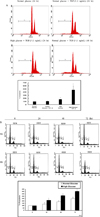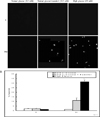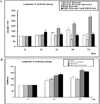Abstract
Background
The glomerulus is a complex physiological structure, as well as selective filtration barrier in the control of renal blood flow and blood pressure. Glomerular epithelial cells may play an important role in development of diabetic nephropathy. Apoptosis of the glomerular epithelial cells are characterized by disappearance of a selective filtration barrier. TGF-Β is a key factor in the development of diabetic nephropathy because of its effects on the accumulation of extracellular matrix and mesangial cell proliferation. We examined whether the high glucose and TGF-Β induce the apoptosis in cultured rat glomerular epithelial cells.
Methods
Glomerular epithelial cells were cultured from rat glomeruli and conditioned with different concentration of TGF-Β or high-glucose. We measured apoptosis of cultured rat glomerular epithelial cell conditioning with different concentration of TGF-Β or high-glucose by using DNA electrophoresis.
Figures and Tables
Fig. 1
Cultured renal epithelial cells were exposed to normal glucose (5.5 mM), high glucose (25 mM), normal glucose (5.5 mM) plus TGF-β (1 ug/mL), high glucose (25 mM) plus TGF-β (1 ug/mL). (A) DAPI stain in renal epithelial cells treated with high glucose and TGF-β. Apoptotic DNA fregmentation of cells treated with high glucose and TGF-β were increased in DAPI stain. (B) The mean ± S.D. of the three different experiments expressed as number of apoptotic cells per normal cells are shown in the graph.
*p < 0.05 versus controls.

Fig. 2
High glucose and TGF-β induce apoptosis in renal epithelial cells.
A. Cells were exposed to normal glucose (5.5 mM), normal glucose (5.5 mM) plus TGF-β (1 ng/mL), high glucose (25 mM), high glucose (25 mM) plus TGF-β (1 ng/mL) for 24 hr after which nuclei were stained by PI stain and analysed by flow cytometry. The mean ± S.D. of the three different experiments expressed as number of apoptotic cells per total cells are shown in the graph.
*p < 0.05 versus controls compared.
B. Cells were exposed to normal glucose (5.5 mM), high glucose (25 mM) plus TGF-β (1 ng/mL) for 24, 48, 72 hr were stained by PI stain and analysed by flow cytometry. The mean ± S.D. of the three different experiments expressed as number of apoptotic cells per total cells are shown in the graph.
*p < 0.05 versus controls.

Fig. 3
High glucose induced apoptosis in renal epithelial cells.
After cells were exposed to starvation state for 24 h, they were exposed to normal glucose (5.5 mM), normal glucose (5.5 mM) plus mannitol (19.5 mM), high glucose (25 mM) for 24 hr. A. Renal epithelial cells were stained by TUNEL stain. B. Three types of bars (white, gray, black) indicate percentage of apoptotic cells per total number. The mean ± S.D. of the three different experiments expressed as number of apoptotic cells per total cells are shown in the graph.
*p < 0.05 versus controls compared.

Fig. 4
A. Effects of glucose concentration (5.5 mM, 25 mM) on caspase-3 activity. Time course of caspase 3-activity of renal epithelial cells induced by high glucose (25 mM). The level of caspase-3 activity in high glucose (25 mM) was significantly increased compared with the control cells at 24, 48, 72 hr. B. Effects of TGF-β treatment (1 ng/mL) on caspase-3 activity. Caspase-3 activity was increased in the cells treated with normal glucose (5 mM) plus TGF-β (1 ng/mL), high glucose (25 mM), high glucose plus TGH-β (1 ng/mL) at 24 hr. At 48 hr, caspase-3 activity was increased in group treated with high glucose.
*p < 0.05 compared wth normal glucose (5.5 mM).

Fig. 5
Western blot assay about p21 Cip, p27 Kip of renal epithelial cells 12, 24, 48, 72 hours after cell lysis with IPH lysis buffer. A. Western blot shows p21 Cip level and p27 Kip level after treatment of high glucose. B. p21 Cip and p27 Kip concentration were measured at 12, 24, 48, 72 hr after normal (5.5 mM), high (25 mM) glucose treatment.

References
5. Lee SH, Bae JS, Park SH, Lee BH, Park RW, Choi JY, Park JY, Ha SW, Kim YL, Kwon TH, Kim IS. Expression of TGF-Β induced matrix protein Big-h3 is up-regulated in the diabetic rat kidney and human proximal tubular epithelial cells treated with high glucose. Kidney International Vol. 2003. 64:1012–1021.
6. Raptis AE, Viberti G. Pathogenesis of diabetic nephropathy. Exp Clin Endocrinol Diabetes 109 Suppl. 2001. 2:424–437.
7. Pagtalunan ME, Miller PL, Jumping-Eagle S, Nelson RG, Myers BD, Rennke HG, Coplon NS, Sun L, Meyer TW. Podocyte loss and progressive glomerular injury in type II diabetes. J Clin Invest. 1997. 99:342–348.
8. Fries JW, Sandstrom DJ, Meyer TW, Rennke HG. Glomerular hypertrophy and epithelial cell injury modulate progressive glomerulosclerosis in the rat. Lab Invest. 1989. 60:205–218.
9. Kriz W, Gretz N, Lemley KV. Progression of glomerular diseases is the podocye the culprit? Kidney Int. 1998. 54:687–697.
10. Kriz W, Elger M, Nagata M, Kretzler M, Uiker S, Koeppen-Hageman I, Tenschert S, Lemley KV. The role of podocytes in the development of glomerular sclerosis. Kidney Int Suppl. 1994. 45:64–72.
11. Meyer TW, Bennett PH, Nelson RG. Podocyte number predicts long-term urinary albumin excretion in Pima Indians with Type II diabetes and microalbuminuria. Diabetologia. 1999. 42:1341–1344.
12. Dalla Vestra M, Masiero A, Roiter AM, Saller A, Crepaldi G, Fioretto P. Is podocyte injury relevant in diabetic nephropathy? Studies in patients with type 2 diabetes. Diabetes. 2003. 52:1031–1035.
13. Rennke HG. How does glomerular epithelial cell injury contribute to progressive glomerular damage? Kidney Int Suppl. 1994. 45:58–63.
14. Kerjaschki D. Dysfunctions of cell biological mechanisms of visceral epithelial cell (podocytes) in glomerular diseases. Kidney Int. 1994. 45:300–313.
15. Nagata M, Kriz W. Glomerular damage after uninephrectomy in young rats. II. Mechanical stress on podocytes as a pathway to sclerosis. Kidney Int. 1992. 42:148–160.
16. Mishra R, Emancipator SN, Kern T, Simonson MS. High glucose evokes an intrinsic proapoptotic singnaling pathway in mesangial cells. Kidney Int. 2005. 67:82–93.
17. Border WA, Noble NA. Transforming growth factor beta in tissue fibrosis. N Engl J Med. 1994. 331:1286–1292.
18. Peters H, Noble NA, Border WA. Transforming growth factor-beta in human glomerular injury. Curr Opin Nephrol Hypertens. 1997. 6:389–393.
19. Fumo P, Kuncio GS, Ziyadeh FN. PKC and high glucose stimulate collagen alpha 1 (IV) transcriptional activity in a reporter mesangial cell line. Am J Physiol. 1994. 267:632–638.
20. Kreisberg JI, Hoover RL, Karnovsky MJ. Isolation and characterization of rat glomerular epithelial cells in vitro. Kidney Int. 1978. 14:21–30.
21. Sharma K, Ziyadeh FN. Biochemical events and cytokine interactions linking glucose metabolism to the development of diabetic nephropathy. Semin Nephrol. 1997. 17:80–92.
22. Sharma K, Ziyadeh FN. Renal hypertrophy is associated with upregulation of TGF-beta 1 gene expression in diabetic BB rat and NOD mouse. Am J Physiol. 1994. 267:1094–1101.
23. Nakamura T, Fukui M, Ebihara I, Osada S, Nagaoka I, Tomino Y, Koide H. mRNA expression of growth factors in glomeruli from diabetic rats. Diabetes. 1993. 42:450–456.
24. Sharma K, Jin Y, Guo J, Ziyadeh FN. Neutralization of TGF-beta by anti-TGF-beta antibody attenuates kidney hypertrophy and the enhanced extracellular matrix gene expression in STZ-induced diabetic mice. Diabetes. 1996. 45:522–530.
25. Ziyadeh FN, Hoffman BB, Han DC, Iglesias-De La Cruz MC, Hong SW, Isono M, Chen S, McGowan TA, Sharma K. Long-term prevention of renal insufficiency, excess matrix gene expression, and glomerular mesangial matrix expansion by treatment with monoclonal antitransforming growth factor-beta antibody in db/db diabetic mice. Proc Natl Acad Sci U S A. 2000. 97:8015–8020.
26. Ziyadeh FN, Sharma K, Ericksen M, Wolf G. Stimulation of collagen gene expression and protein synthesis in murine mesangial cells by high glucose is mediated by autocrine activation of transforming growth factor-beta. J Clin Invest. 1994. 93:536–542.
27. van Det NF, Verhagen NA, Tamsma JT, Berden JH, Bruijn JA, Daha MR, van der Woude FJ. Regulation of glomerular epithelial cell production of fibronectin and transforming growth factor-beta by high glucose, not by angiotensin II. Diabetes. 1997. 46(5):834–840.
28. Schiffer M, Bitzer M, Roberts IS, Kopp JB, ten Dijke P, Mundel P, Bottinger EP. Apoptosis in podocytes induced by TGF-beta and Smad7. J Clin Invest. 2001. 108:807–816.
29. Schiffer M, Schiffer LE, Gupta A, Shaw AS, Roberts IS, Mundel P, Bottinger EP. Inhibitory smads and tgf-Beta signaling in glomerular cells. J Am Soc Nephrol. 2002. 13:2657–2666.
30. Kim JH, Kim BK, Moon KC, Hong HK, Lee HS. Activation of the TGF-beta/Smad signaling pathway in focal segmental glomerulosclerosis. Kidney Int. 2003. 64:1715–1721.
31. Bhaskaran M, Reddy K, Radhakrishanan N, Franki N, Ding G, Singhal PC. Angiotensin II induces apoptosis in renal proximal tubular cells. Am J Physiol Renal Physiol. 2003. 284:955–965.
32. Ding G, Reddy K, Kapasi AA, Franki N, Gibbons N, Kasinath BS, Singhal PC. Angiotensin II induces apoptosis in rat glomerular epithelial cells. Am J Physiol Renal Physiol. 2002. 283:173–180.
33. Sanwal V, Pandya M, Bhaskaran M, Franki N, Reddy K, Ding G, Kapasi A, Valderrama E, Singhal PC. Puromycin aminonucleoside induces glomerular epithelial cell apoptosis. Exp Mol Pathol. 2001. 70:54–64.
34. Wolf G, Shankland SJ. p27 Kip1: The "rosebud" of Diabetic nephropathy? J Am Soc Nephrol. 2003. 14:819–822.




 PDF
PDF ePub
ePub Citation
Citation Print
Print


 XML Download
XML Download